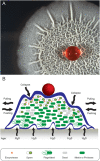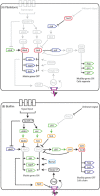Biofilm formation by Bacillus subtilis: new insights into regulatory strategies and assembly mechanisms
- PMID: 24988880
- PMCID: PMC4238804
- DOI: 10.1111/mmi.12697
Biofilm formation by Bacillus subtilis: new insights into regulatory strategies and assembly mechanisms
Abstract
Biofilm formation is a social behaviour that generates favourable conditions for sustained survival in the natural environment. For the Gram-positive bacterium Bacillus subtilis the process involves the differentiation of cell fate within an isogenic population and the production of communal goods that form the biofilm matrix. Here we review recent progress in understanding the regulatory pathways that control biofilm formation and highlight developments in understanding the composition, function and structure of the biofilm matrix.
© 2014 The Authors. Molecular Microbiology published by John Wiley & Sons Ltd.
Figures


References
-
- Bai U, Mandic-Mulec I, Smith I. SinI modulates the activity of SinR, a developmental switch protein of Bacillus subtilis, by protein-protein interaction. Genes Dev. 1993;7:139–148. - PubMed
Publication types
MeSH terms
Substances
Grants and funding
LinkOut - more resources
Full Text Sources
Other Literature Sources
Molecular Biology Databases

